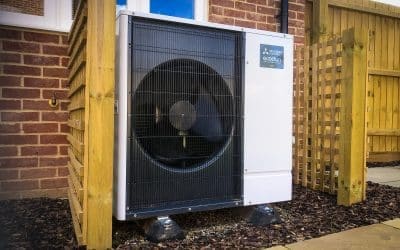A lot of confusion exists between ground source heat pumps (GSHPs) and geothermal energy thanks to their similar-sounding terminologies. What’s more, these two terms are used interchangeably which further adds to the confusion. Both GSHP and geothermal energy are renewable heating solutions that harness heat from the ground, which is why most of us tend to mix them up.
All things considered, geothermal energy and ground source heat pump are two vastly different technologies with different processes. As we read along further, we will see that only one of these technologies is a feasible option for heating individual properties.
Here, we will highlight the major point of differences between these technologies and will also see how they each work.
Ground Source Heat Pump
A GSHP or a ground source heat pump extracts heat stored in the soil or water beneath the ground’s surface and transfers it to cater to the hot water and heating requirements of a property. It can extract heat from as much as 200 metres below the surface.
The heat trapped in the ground is produced when sun rays fall on the ground surface. Approximately 15 metres below the surface, the earth maintains a constant temperature throughout the year which is why the heat remains accessible even in the colder months. According to the British Geological Survey, this temperature is roughly equal to the mean annual air temperature that is between 8º to 11ºC.
A series of fluid-filled pipes with antifreeze are concealed beneath the ground’s surface and the heat pump extracts the trapped heat and passes it through the heat exchanger. Then, this heat is circulated throughout your property to provide you with heating and hot water all round the year.
Geothermal Energy
Geothermal energy is produced by tapping into the heat stored in the earth’s core. Here, temperatures can reach up to 6000ºC. For you to reach this heat, you would need to drill a deep borehole that is between 500 to 2500 metres deep and fill it with water.
This water is then heated naturally by the hot rock. The vapour produced by this hot water is then used to drive turbines and generate electricity. The heat from the earth’s core emerges naturally in countries that have more tectonic activity. Hot springs and geysers are a good example of tectonic activity, commonly seen in New Zealand and Iceland.
In these countries, using geothermal energy to extract heat is easier and affordable because the natural heat source can be accessed with shallow drilling. On the other hand, in countries without natural geysers, it’s fairly uneconomical to tap into.
GSHP vs. Geothermal Energy
Typically, geothermal energy is extracted by large plants using heavy-duty equipment. Given the scale of efforts required, it isn’t feasible to heat individual properties or small communities using this setup.
Geothermal energy isn’t the most viable option for people living in tectonically stable regions because it can be accessed only through large-scale and expensive drilling operations.
On the other hand, a ground source heat pump is a more practical option for sustainable heating. Although GSHP installation requires an upfront investment, you can save greatly on energy bills. Add to the mix the financial rewards from the government’s RHI scheme and the installation basically pays for itself.
Click here to get your free quick quote!
Alternative Renewable Heating Solutions
While installing a ground source heat pump is a great choice, it might not be the most suitable option for a property with limited outdoor space. Sufficient outdoor space is required to dig boreholes and install ground loops. Unfortunately, not everyone might have the required space available to get the job done.
That doesn’t mean you don’t have other options for renewable heating because you do. Let’s take a look at these alternatives!
Air Source Heat Pump (ASHP)
With equipment resembling air conditioning units, air source heat pumps are a great alternative to GSHPs. They sit on the outer wall of the property which means very little space is required.
ASHP and GSHP are similar in the way they function which makes them ideal as domestic heat pumps. The main difference is that instead of the ground’s surface, they use latent ambient air to absorb and convert heat. They work throughout the year even during the colder months when the weather is more unpredictable.
Biomass Boilers
Biomass boilers are another great alternative. Instead of burning fossil fuels, biomass boilers use wood pellets and logs to generate heat. These fuels are made from wood waste and from other biowaste. These fuels are comparatively more affordable as you don’t have to factor in fluctuating prices. What’s more, biofuel can be sourced locally.
Conclusion
Ground source heat pumps and geothermal energy are fundamentally different approaches to use the natural heat reserves that exist below the earth’s surface.
If you live in a region with high tectonic activity, only then it would be feasible for you to use geothermal energy, and this would typically be managed by the government or an energy corporation. It requires drilling hundreds and thousands of metres deep into the earth’s surface and the costs and complexities involved in this process means that it works only for large-scale geothermal schemes.
In comparison, a GSHP can be installed on a much smaller scale and at a relatively modest budget. It is ideal to heat individual properties or a small community. Ground source heat pumps are an efficient and affordable way to heat your home comfortably while significantly reducing your carbon footprint.
Get in touch with us today to make the most of this renewable installation!





